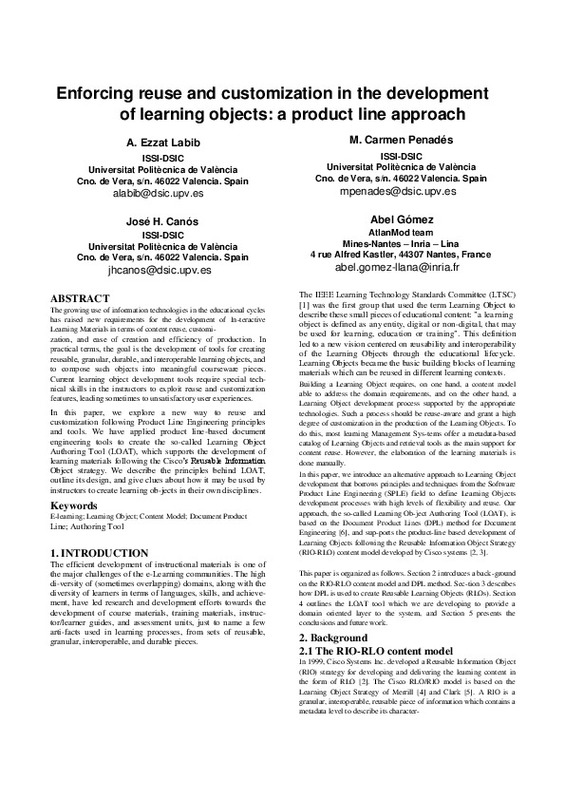JavaScript is disabled for your browser. Some features of this site may not work without it.
Buscar en RiuNet
Listar
Mi cuenta
Estadísticas
Ayuda RiuNet
Admin. UPV
Enforcing reuse and customization in the development of learning objects: a product line approach
Mostrar el registro sencillo del ítem
Ficheros en el ítem
| dc.contributor.author | Ezzat Labib Awad, Ahmed
|
es_ES |
| dc.contributor.author | Penadés Gramage, María Carmen
|
es_ES |
| dc.contributor.author | Canos Cerda, José Hilario
|
es_ES |
| dc.contributor.author | Gómez Llana, Abel
|
es_ES |
| dc.date.accessioned | 2016-06-09T08:40:51Z | |
| dc.date.available | 2016-06-09T08:40:51Z | |
| dc.date.issued | 2015-04 | |
| dc.identifier.isbn | 978-1-4503-3196-8 | |
| dc.identifier.uri | http://hdl.handle.net/10251/65563 | |
| dc.description | © ACM 2015.This is the author's version of the work. It is posted here for your personal use. Not for redistribution. The definitive Version of Record was published in ACM, In Proceedings of the 30th Annual ACM Symposium on Applied Computing (pp. 261-263). http://dx.doi.org/10.1145/2695664.2695991. | es_ES |
| dc.description.abstract | The growing use of information technologies in the educational cycles has raised new requirements for the development of In-teractive Learning Materials in terms of content reuse, customi-zation, and ease of creation and efficiency of production. In practical terms, the goal is the development of tools for creating reusable, granular, durable, and interoperable learning objects, and to compose such objects into meaningful courseware pieces. Current learning object development tools require special technical skills in the instructors to exploit reuse and customization features, leading sometimes to unsatisfactory user experiences. In this paper, we explore a new way to reuse and customization following Product Line Engineering principles and tools. We have applied product line-based document engineering tools to create the so-called Learning Object Authoring Tool (LOAT), which supports the development of learning materials following the Cisco s Reusable Information Object strategy. We describe the principles behind LOAT, outline its design, and give clues about how it may be used by instructors to create learning ob-jects in their own disciplines. | es_ES |
| dc.description.sponsorship | This project has been funded with support from the European Commission. This publication [communication] reflects the views only of the author, and the Commission cannot be held responsible for any use which may be made of the information contained therein. The work of J.H. Canós and M.C. Penadés is partially funded by the Spanish MEC under grant TIPEx (TIN2010-19859-C03-03). | es_ES |
| dc.format.extent | 3 | es_ES |
| dc.language | Inglés | es_ES |
| dc.publisher | ACM | es_ES |
| dc.rights | Reserva de todos los derechos | es_ES |
| dc.subject | E-learning | es_ES |
| dc.subject | Learning object | es_ES |
| dc.subject | Content model | es_ES |
| dc.subject | Document product line | es_ES |
| dc.subject | Authoring tool | es_ES |
| dc.subject.classification | LENGUAJES Y SISTEMAS INFORMATICOS | es_ES |
| dc.title | Enforcing reuse and customization in the development of learning objects: a product line approach | es_ES |
| dc.type | Comunicación en congreso | es_ES |
| dc.identifier.doi | 10.1145/2695664.2695991 | |
| dc.relation.projectID | info:eu-repo/grantAgreement/MICINN//TIN2010-19859-C03-03/ES/TECNOLOGIAS DE LA INFORMACION PARA LA PLANIFICACION Y EL ENTRENAMIENTO DE SITUACIONES DE EMERGENCIA/ | es_ES |
| dc.rights.accessRights | Abierto | es_ES |
| dc.contributor.affiliation | Universitat Politècnica de València. Departamento de Sistemas Informáticos y Computación - Departament de Sistemes Informàtics i Computació | es_ES |
| dc.description.bibliographicCitation | Ezzat Labib Awad, A.; Penades Gramage, MC.; Canos Cerda, JH.; Gómez Llana, A. (2015). Enforcing reuse and customization in the development of learning objects: a product line approach. ACM. doi:10.1145/2695664.2695991 | es_ES |
| dc.description.accrualMethod | S | es_ES |
| dc.relation.conferencename | 30th ACM/SIGAPP Symposium On Applied Computing (SAC 2015) | es_ES |
| dc.relation.conferencedate | April 13-17, 2015 | es_ES |
| dc.relation.conferenceplace | Salamanca, Spain | es_ES |
| dc.relation.publisherversion | http://dl.acm.org/citation.cfm?doid=2695664.2695991 | es_ES |
| dc.type.version | info:eu-repo/semantics/publishedVersion | es_ES |
| dc.relation.senia | 298169 | es_ES |
| dc.contributor.funder | European Commission | es_ES |
| dc.contributor.funder | Ministerio de Ciencia e Innovación | es_ES |
| dc.description.references | IEEE LTSC, http://ieee-sa.centraldesktop.com/ltsc/ | es_ES |
| dc.description.references | Cisco Systems. 1999. Reusable information object strategy, "Definition, Creation over view, and guidelines". | es_ES |
| dc.description.references | Cisco Systems. 2003. Reusable learning object strategy: Designing and developing learning objects for multiple learning approaches, Version 4.5 {white paper}. | es_ES |
| dc.description.references | Merrill, M. D. 1983. Component display theory. In: Instructional design theories and models. Erlbaum Associates. | es_ES |
| dc.description.references | Clark, R. 1989. Developing technical training: a structured approach for the development of classroom and computer-based instructional materials. Performance Technology Press, New York. | es_ES |
| dc.description.references | A. Gómez, M. C. Penadés, J. H. Canós, M. R. S. Borges, M. Llavador. 2014. A framework for variable content document generation with multiple actors. Information and Software Technology, 2014, ISSN 0950--5849. | es_ES |
| dc.description.references | Bloom, BS (ed.). 1956. "Taxonomy of Educational Objectives". Vol. 1: Cognitive Domain. New York: McKay. | es_ES |






![[Cerrado]](/themes/UPV/images/candado.png)


